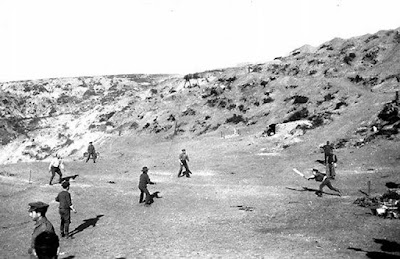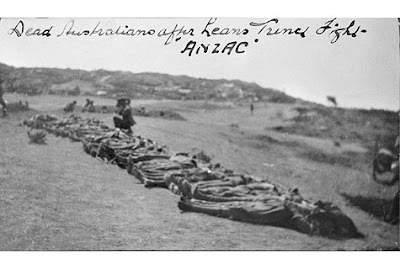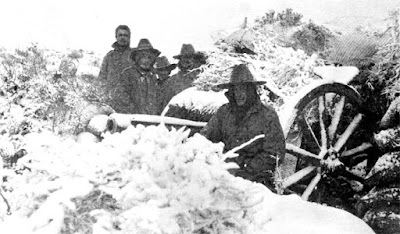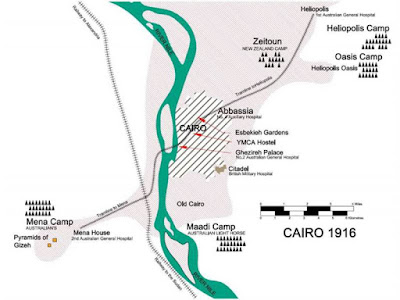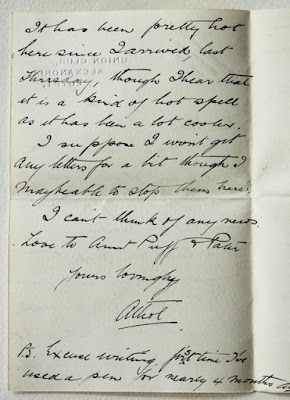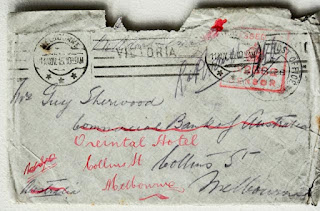This is the 3rd Australian General Hospital 3AGH) on Lemnos Island, Greece in 1915 - a row of tents. Athol was admitted to this facility on 19 September with enteritis.
J01438 - Australian War Memorial image taken by A W Savage on Lemnos Island, Greece, 1915.
The AWM caption reads: 'Medical and nursing sisters of 3rd Australian General Hospital (3AGH) in the tent lines with patients. Lieutenant Colonel Sydney Jamieson may be the officer (left).'
In April 1915, the War Office in London requested the Australian Government provide a military hospital and a month after this request the
Moolton set sail from Circular Quay, Sydney (15 May 1915). Australian doctors and nurses aboard were sent first to Egypt and then on to England. They were expecting to be provided with training and equipment and then be shipped to France.
However, in mid-July they were ordered to Lemnos in support of the troops serving on the Gallipoli peninsular.
An Australia/Italian surgeon Dr Thomas Henry Fiashi, was appointed commanding officer of the No3 Australian General Hospital. He was aged 62 at the time of his appointment. (see more about Dr Fiashi below).
The hospital's male staff arrived at Lemnos on 27-28 July, they were followed by the Australian Army Nursing Services (AANS) personnel on 5 August (the Battle of Lone Pine was to take place the next day). When the nurses arrived at Mudros Harbour they were informed that there was no accommodation for them on the island and that the supply ship
Ascot had not arrived. Lieutenant Colonel J A Dick noted '
the officers and men are bivouacking among the rocks and stones and thistles of the camp site - there are no tents: no store ship'. The nurses were transferred to another hospital ships:
Simla and
Formosa. The nurses personal luggage was on the store ship.
By 7 August most of the hospital site was pegged out and a number of tents and 'marquees' had been erected. The hospital was 'opened' on 8 August with the nurses arriving the day before as their tented accommodation had been arranged. Still there was no store ship. These resources were supplied from army stores already on the Island.
Arrival of first detachment of Sisters, 8 August 1915
[AW Savage, photo album, PXE 698, Mitchell Library, State Library of New South Wales]
It is just as well that those in charge had shown considerable initiative and resourcefulness to set up this hospital as the day after the official opening, on 9 August, more than 200 wounded and sick had were admitted. Four days later there were more than 800 patients. This was the influx of wounded as a result of the August offensive.
Colonel Dick wrote: '
the officers mess and all utensils were given up today for wounded as was the orderly office marquee. Still no store ship....AGH personnel still bivouacking...sick and wounded on the ground on mackintosh sheets and blankets or palliasses on floor of tents."
During the next few days thousands of wounded were brought for treatment at the hospitals on Lemnos, most suffering from gunshot wounds. Although it was Australian and unit policy to treat Australian personnel in an Australia hospital, military personnel from all the allied units were treated in whatever hospital was available.
The stores ship,
Ascot, arrived on 20 August.
Unsurprisingly, up until the end of August the cause of death in the 3rd Australian General Hospital was primarily 'gunshot wounds'. After August the primary cause of death was disease.
Athol was admitted with enteritis on 19 September. He was not the only one. The hospital staff themselves, no doubt run down by weeks of strain and endless work in extreme conditions also contracted disease and needed to be evacuated. These included the commanding officer, Dr Thomas Henry Fiashi (evacuated to England with Beriberi in November) and Dr Jamieson (in top image) and Dr Lockhart Gibson (mentioned in next letter). It must have been a great loss to have these men leave Lemnos when they were so desperately needed.
_______________________**___________________________
More about the men in this blog-post.
Lt Col Jamieson could have originally come from Tasmania - he attended school there. He went on to read Arts at the University of Sydney and continued his studies in Scotland receiving a Bachelor of Medicine from the College of Surgeons, Edinburgh. He enlisted on 1 May 1915 and after a short stay in Egypt was sent to the No 3 Australian General Hospital on Lemnos Island, Greece. He was taken ill, evacuated to England but in May 1916 returned to Australia.
Dr Jamieson went on to lecture at Sydney University and also worked in an honorary capacity at Randwick Barracks. He died in 1925.
Dr Thomas Henry Fiashi was an Italian-Australian. His mother was English and father an Italian medical practitioner. Dr Fiashi arrived in Australia aged 21 and immediately tried his luck on the Queensland goldfields - a sign of his adventurous spirit evident throughout his life. Perhaps not so successful in the goldfields, he moved to Sydney where he resumed practice as a surgeon at St Vincent's hospital. He married a former nun whom he met at St Vincent's, Catherine Reynolds. They returned to Italy for a time and he went on to practice with the Italian Army in Abyssinia. They traveled to the US where he advanced his surgical techniques and later returned to practice in Windsor, on the Hawkesbury (where he also started a vineyard) and Sydney. He served with the Australians in the Boer War, being mentioned in dispatches twice and awarded the DSO.
In May 1915 he enlisted and embarked on the
Moolton with the 3rd Australian General Hospital as its commanding officer.
He contracted beriberi (a serious disease contracted by lack of Vitamin B), probably as a result of the poor quality rations on Lemnos and was invalided to Enlgand in November 1915. He resigned his commission in the AIF and transferred to the Italian forces where he was a surgeon in the military hospital with his wife working for the Italian Red Cross. They returned to Australia in October 1917 where Dr Fiashi joined the Australian Army Medical Corps Reserve. He died in 1927 in Sydney.
The famous boar statue outside the Sydney hospital was erected in his memory and that of his son, Piero, who also served with the 1st AIF as a medical practitioner. This well-loved statue was a gift of Marchesa Clarissa Torrigiani (one of Dr Fiashi's daughter and Piero's sister).
Matron Grace Wilson, the senior nurse in the AAMS. Matron Wilson was a Queenslander who led a team of Australian nurses who expertly cared for and comforted our wounded on Lemnos in the most trying conditions.
Matron Grace Wilson, on Lemnos Island, 1915.
'Australian Heroines Of World War One', by Susanna de Vries.
In the first few days in August when the wounded arrived from the Peninsular, many men were left outside in the Summer heat as there were so few tents. Furthermore, the medical staff lacked equipment, medical supplies, even bandages and clean water were scarce. Matron Wilson started the practice of tearing up the nurses' petticoats in order to make bandages. The injured men could not even be washed and flies/disease quickly became a concern.
Matron Wilson lost her brother, Graham, on the Gallipoli peninsular.





